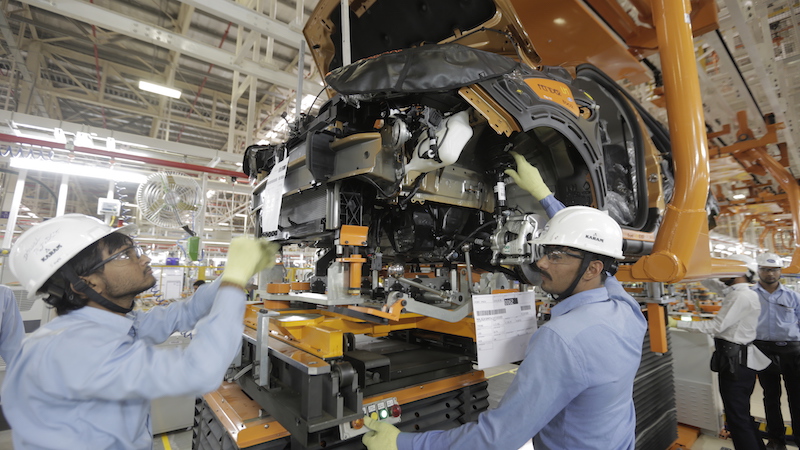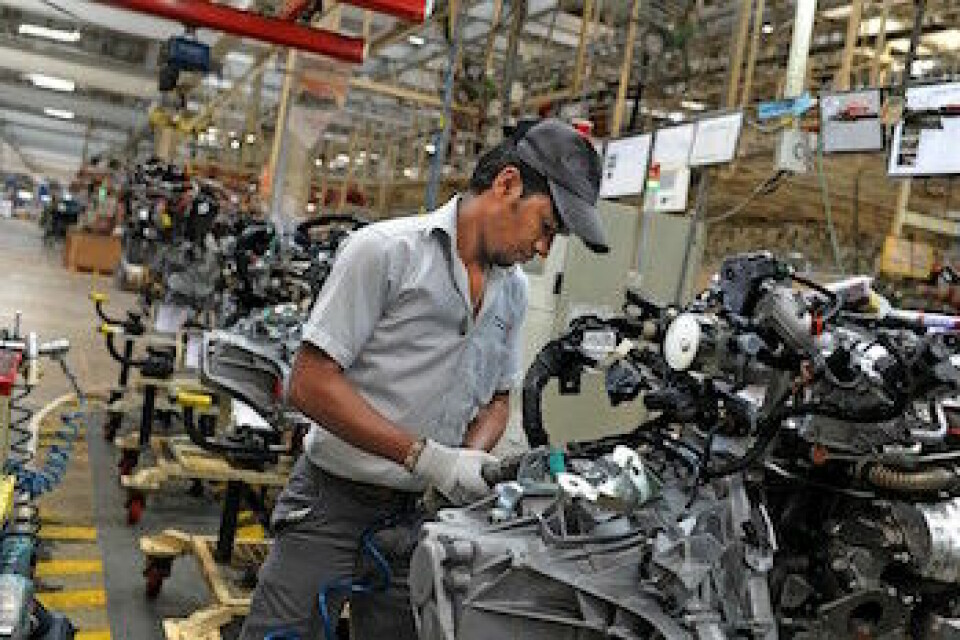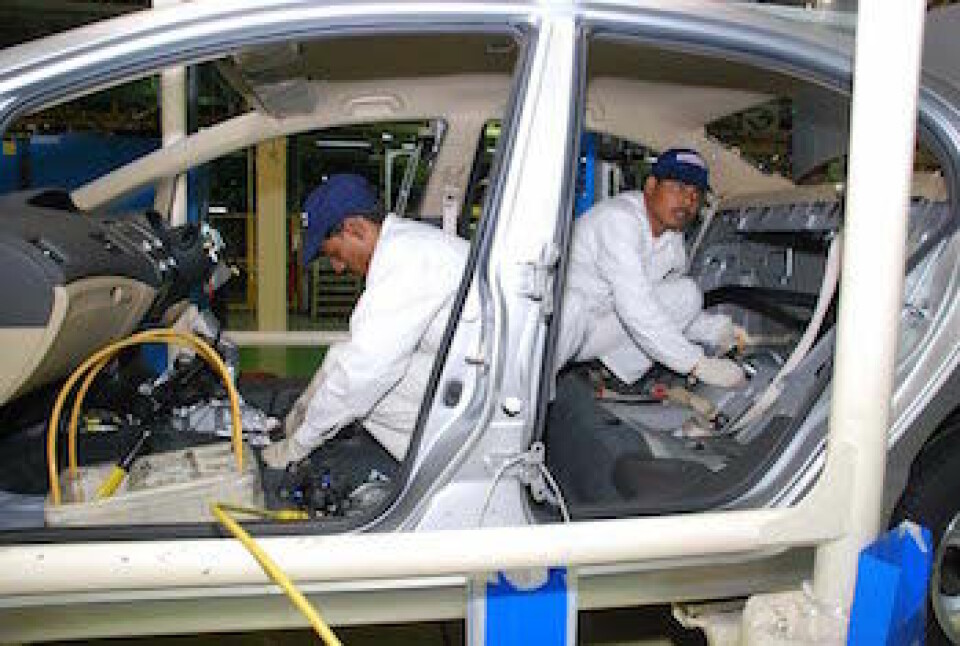Made in India... for export
The country has emerged as a major market for the world’s car companies as well as a growing export hub Several car companies are expanding their Indian production capacity. The biggest, Maruti Suzuki, is in the midst of a $1 billion investment as part of its 'Vision 2.0' strategy which aims to reach 2m sales by 2020 and to launch 15 new models by this time. Most of these will be based on Suzuki models, especially its kei platform, with the first due to be the next Alto. However, Maruti’s Indian engineers will play leading roles in the development of at least three new models, in a manner similar to the development path of the Vitara Brezza, which was designed specifically for the Indian market.
Several car companies are expanding their Indian production capacity. The biggest, Maruti Suzuki, is in the midst of a $1 billion investment as part of its 'Vision 2.0' strategy which aims to reach 2m sales by 2020 and to launch 15 new models by this time. Most of these will be based on Suzuki models, especially its kei platform, with the first due to be the next Alto. However, Maruti’s Indian engineers will play leading roles in the development of at least three new models, in a manner similar to the development path of the Vitara Brezza, which was designed specifically for the Indian market.
During fiscal year 2016-2017, expansion at Maruti Suzuki will see an 8-9% increase in production of around 100,000-120,000 units a year. However, until a new Maruti factory in Gujarat comes fully on stream there may actually be a temporary shortage of capacity; this new facility will have an initial annual capacity of 250,000 units, rising to 325,000 by 2022, and should relieve pressure on the old Gurgaon and Manesar plants. In parallel with the expansion of Maruti facilities, Suzuki is planning its own 100,000-unit plant in Gujarat.
At India’s second largest manufacturer, Hyundai, production is close to capacity, reaching nearly 96% utilisation in 2015, following the success of the Creta compact SUV and the i20 small car. Consideration is being given to the establishment of an additional factory, but Hyundai may achieve its target of 1m units per year by expanding the existing site, rather than by adding an all-new facility; as noted below, a Kia plant is under consideration, although this may take three years to come to fruition.
Adding shiftsVolkswagen added a third shift at its Pune factory in March 2015 to meet export demand and to accommodate production of the Ameo small sedan (a small version of the Vento sedan), which is to be launched in late 2016. The expansion at the VW plant, which also makes the Skoda Rapid, follows expansion in 2014 at Aurangabad where various Audis and the Skoda Octavia are made.
At Renault-Nissan’s Oragadam plant in Chennai, production capacity has been increased by adding a night shift from April 2016 to cope with anticipated demand for the Renault Kwid and a third model for the Datsun brand. This is an import-export plant, with Nissan’s Sunny and Micra exported worldwide, especially to Latin America and Africa; exports of the Micra to Europe were lost with the switch to Renault’s Flins plant, France, early this year. The addition of the third shift in 2016 represents a turnaround from the situation in 2015, when about 1,000 jobs were cut at Chennai as production halved to 20 vehicles an hour; reports had suggested that 3,000 jobs could go, although in fact fewer were lost and some returned with the third shift.
“Made in India” – and exportedIn parallel with increased production for growing local demand, emphasis is being placed on the “Made in India” label as the country develops as an export hub. A good example is the Baleno, made at Maruti Suzuki’s plant at Manesar in Haryana, which will be exported to more than 100 countries, including Japan and various EU markets.
Since 2014, the VW plant at Pune has exported to over 30 countries outside India. Recent annual production has been around 120,000 units, but this should rise to 200,000 by the end of the decade. Exports totalled 25,000 in 2013, were just over 64,000 in 2014 and reached 75,000 in 2015; Mexico is the major export market, with Argentina second. Both markets receive the Vento, which is sold as the Polo in Argentina. Other markets served are in Africa and Asia; for example, 5,000 component sets are shipped annually to Malaysia for local assembly.
In parallel with increased production for rising local demand, the “Made in India” label is being emphasised as the country develops as an export hub
Ford has also used India as an export hub for several years, with mixed success. The Indian-made Ecosport SUV has been exported worldwide, including Europe, where it has performed poorly against models such as the Nissan Juke or the Opel/Vauxhall Mokka. Despite this, the company is pressing ahead with European exports; the Figo, made at the Sanand plant, should reach selected European markets during the second half of 2016, where it will be sold as the Ka+ and targeted against the Nissan Micra and Hyundai i10 especially.

GM also plans to use India as an export hub, adding a compact sedan, Essentia, which will be made in India from 2017. This is a sedan version of the Beat hatchback which is manufactured in India for local and export demand. Ahead of the Essentia’s launch, GM intends to more than double exports of existing models from India to 50,000 units in 2016, mainly for Africa and Latin America, especially Chile and Mexico.
Although GM has ambitious plans to sell 400,000 vehicles a year in the country by the mid-2020s and in parallel to increase exports from its Indian facilities, things have not gone entirely smoothly in the recent past; GM India reported losses in each of the last two financial years. A consequence of this was the closure of one of GM’s two plants in the country, at Halol in Gujarat, which has an annual capacity of around 110,000 units; production is now concentrated at Talegaon, which has a capacity of about 170,000 units. With just one operational factory, it is difficult to see how the company can achieve its objective of reaching 400,000 sales, at least not without one or more new plants, or the reopening of Halol, or indeed an unlikely large-scale switch to imports.
Increased local sourcingA key aspect of increased production in India in recent times has been the increase in local content. For example, VW’s $250m Indian investment plan, announced in 2014, includes provision to raise the local content of Indian-made vehicles from 65-70% to over 90%, much of this local sourcing increase being achieved with a new engine and transmission plant.
It is not just the volume brands which are increasing local Indian content. By the end of 2015, BMW had achieved 50% local content, more than double the 20% achieved for its Indian-made models a year earlier; previously its main locally sourced component had been the engine for the X5 SUV from Force Motors (which also makes engines for Mercedes cars assembled in India). In recent times, BMW has added local sourcing of the dashboard, door panels, diesel engines and gearboxes; the ability to source powertrain systems in India is a major boost to increasing production and accelerating delivery times which had been hitherto determined by long-distance shipping schedules.
As well as developing as a global export hub, the country’s engineering skills are being harnessed by the global automotive industry to develop vehicles for markets beyond India. One notable case is Ford, which is setting up a global engineering centre in India. This new unit will oversee the development of a new platform for vehicles targeted at Latin America. Having seen the success that Hyundai and Suzuki have enjoyed by engineering vehicles in India, Ford believes it can benefit from local skills and resources. The first vehicles to be developed in India are expected to be B-segment hatchbacks, sedans and SUVs, essentially replacing the Figo, Aspire and Ecosport models.
Higher specification and premium vehiclesIndia has been known as an entry-level market, but there is a notable trend toward higher-specification vehicles; alongside rising sales of premium brands such as BMW and Mercedes, there is also an increase in specification on volume brands. Maruti Suzuki has set up its own ‘premium’ sales channel, Nexa, through which it is selling the Baleno and S-cross; so far, this has not been a great success and the price of the S-cross has been cut to boost showroom traffic. Customers who bought vehicles prior to the March 2016 price cuts have been offered refunds.
In the same vein, Honda announced that from mid-2017 all its vehicles sold in India would have dual front airbags, a feature which it has been offering in its locally made City small sedan car since early 2016. The 2018 Honda Amaze, currently in development in Japan, will be manufactured in India from mid-2018 and is being designed to incorporate new safety features which will comply with new safety norms, coming into force in 2020.

Arrival of the ChineseTo date, the Chinese have yet to establish a significant presence in India’s automotive sector. However, reports in early April suggested that SAIC and Great Wall are both negotiating with Indian authorities regarding assembly facilities in Pune, Maharashtra State, and possibly elsewhere in India too. The country is a priority for SAIC especially, which plans to open a plant there before going to Russia or Europe; one option reportedly under consideration for SAIC is to take over GM’s currently shuttered plant at Halol.
Still room for more new entrantsKorea’s Hyundai has long been established in India and is in fact the second-largest producer in the country after Maruti-Suzuki. Its sister brand, Kia, is not yet present in India, but is likely to have a production facility in the country within the next three years. Initial reports suggest that Kia would build a new plant of its own rather than make use of the existing Hyundai facilities, and moreover, that the new plant could make vehicles for both brands. As has been the case in other markets, Kia would be most likely to enter India with a localised version of the Rio small hatchback, and given the current global trend, a small SUV is also expected.
Domestic players refuse to stand asideAlthough Maruti has effectively become a subsidiary of Suzuki, Mahindra has stood firm and remained independent; it is now investing in its Korean brand, Ssangyong, in both Korean and Chinese operations. In India, the company is investing around 80 billion rupees ($1.2 billion) in its main light vehicle plants in Maharashtra to enable it to compete better against the growing power of the international vehicle companies in India.
Diesel uncertainty impacting investment decisionsIn general, the diesel emissions issue has been a European problem, but India is one of the very few markets outside Europe with significant diesel uptake; this reflects favourable fiscal treatment by the government in the recent past. However, just as the future of diesel in Europe is somewhat uncertain, Toyota has temporarily halted its investment plans in India while the future of diesel regulation is reviewed. Of particular concern is the ruling, earlier in 2016, by India’s courts which bans the sale of diesels above 2.0 litres in the New Delhi area, (National Capital Region, NCR). Although diesels with engines bigger than 2.0 litres account for just 10% of the market, Toyota is disproportionately affected because its Innova MPV and Fortuner SUV models are powered by big diesel engines. Moreover, Toyota has achieved over 15% of its total Indian sales within the NCR’s boundaries, so any restrictions in diesel sales here will have a clear impact on the company’s position in India.

In parallel with the diesel issue causing a review of Indian investment plans, Toyota has added assembly of hybrid vehicles. The hybrid Camry is already assembled in India and press reports suggest that the Corolla hybrid, currently only made in Japan, is the next hybrid Toyota expects to make in India. Toyota’s problems with legislation hitting sales of large diesel engine vehicles are compounded by the fact that sales of its small cars, for example Etios, have been disappointing. In order to better compete with Maruti, it is understood to be planning to launch the Daihatsu brand, which it now fully owns, in India in the near future.
In the year to March 31 2016, the Indian market was 56% petrol, 4% higher than a year earlier, but 14% higher than in 2012-2013. With fiscal incentives for diesel gradually being removed, the Indian market is changing and companies – such as Toyota – with a production structure focused more on diesels than petrol will have to move fast to respond to such changes in market structure and behaviour.
The next automotive battlegroundThe Indian automotive manufacturing sector is at an interesting stage in its development. The country’s engineering skills are increasingly being harnessed for global model programmes and India is becoming a worldwide export hub; as well as shipments to Europe and Japan, Indian-made vehicles are now found across parts of Asia, Africa and Latin America where there is a lack of manufacturing capacity. The local market too is growing, stimulating further investment, additional shifts and an increase in local sourcing. With almost all of the world’s major carmakers now having a presence in India, the country is set to become the latest battleground for automotive supremacy.


